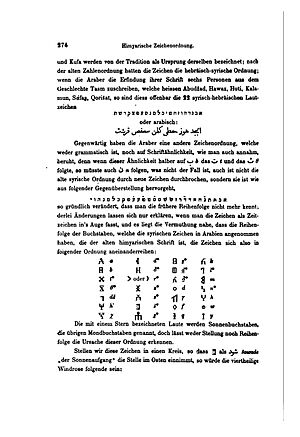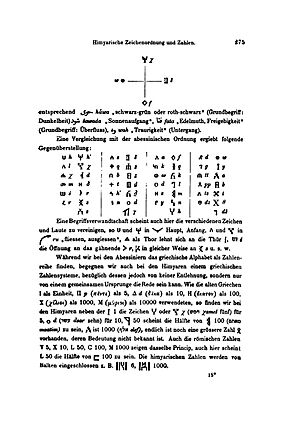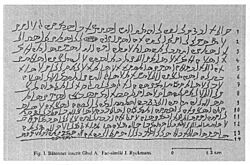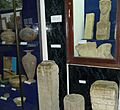Ancient South Arabian script facts for kids
Quick facts for kids Ancient South Arabian script |
|
|---|---|
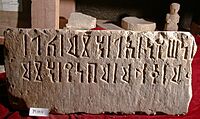 |
|
| Type | Abjad |
| Spoken languages | Old South Arabian, Ge'ez |
| Time period | Late 2nd millennium BCE to 6th century CE |
| Parent systems |
Egyptian hieroglyphs
|
| Child systems | Geʽez |
| Sister systems | Ancient North Arabian |
| Unicode range | U+10A60–U+10A7F |
| ISO 15924 | Sarb |
| Note: This page may contain IPA phonetic symbols in Unicode. | |
The Ancient South Arabian script (also known as Musnad) is an old writing system. It came from the Proto-Sinaitic script around 1500-1000 BCE. People used it to write several Old South Arabian languages like Sabaic and Ge'ez. The oldest examples of this script were found on pottery pieces in Yemen. These pieces are from the late 2nd millennium BCE. This script did not have letters for vowels, which are sounds like 'a', 'e', 'i', 'o', 'u'.
The script became fully developed around 800 BCE. People continued to use it until the 6th century CE. After that, the Arabic alphabet became more common. In Eritrea and Ethiopia, this ancient script changed over time into the Geʽez script. The Ge'ez script then added more symbols and is now used for languages like Amharic and Tigrinya.
Contents
How the Script Works
- It was usually written from right to left. But sometimes, it was written from left to right. When written from left to right, the letters were flipped horizontally, like looking in a mirror.
- A vertical bar mark ( | ) was used to separate words.
- The letters in words were not connected to each other.
- Unlike the modern Arabic alphabet, this script did not use special marks like dots or lines above or below letters.
Musnad vs. Arabic Script
The Musnad script is different from the Arabic script. Most experts believe the Arabic script came from the Nabataean script, which developed from the Aramaic script. This happened around the 4th century AD. The languages written with the Musnad script are also very different from the Arabic language. They differ in how they are written, their words, grammar, and even sounds.
Letters
The Ancient South Arabian script has many letters, each representing a specific sound. These letters are often compared to those in other ancient writing systems like Phoenician, Aramaic, and Hebrew.
Numbers
This script used six special signs for numbers:
| 1 | 5 | 10 | 50 | 100 | 1000 |
|---|---|---|---|---|---|
| 𐩽 | 𐩭 | 𐩲 | 𐩾 | 𐩣 | 𐩱 |
The sign for 50 looks like the sign for 100, but with the bottom part removed. The sign for 1 was also used to separate words. The other four signs could be used as both letters and numbers. Each of these four signs was the first letter of the name of that number.
Another sign (𐩿) was used to show where numbers started and ended. This helped to tell them apart from regular text. For example, 𐩿𐩭𐩽𐩽𐩿
This system worked like Roman numerals. You added the values of the signs together to make any number (except zero). Here are some examples:
- 17 was written as 1 + 1 + 5 + 10: 𐩲𐩭𐩽𐩽
- 99 was written as 1 + 1 + 1 + 1 + 5 + 10 + 10 + 10 + 10 + 50: 𐩾𐩲𐩲𐩲𐩲𐩭𐩽𐩽𐩽𐩽
Here are some sample numbers from one to twenty:
| 1 | 2 | 3 | 4 | 5 | 6 | 7 | 8 | 9 | 10 |
|---|---|---|---|---|---|---|---|---|---|
| 𐩽 | 𐩽𐩽 | 𐩽𐩽𐩽 | 𐩽𐩽𐩽𐩽 | 𐩭 | 𐩭𐩽 | 𐩭𐩽𐩽 | 𐩭𐩽𐩽𐩽 | 𐩭𐩽𐩽𐩽𐩽 | 𐩲 |
| 11 | 12 | 13 | 14 | 15 | 16 | 17 | 18 | 19 | 20 |
| 𐩲𐩽 | 𐩲𐩽𐩽 | 𐩲𐩽𐩽𐩽 | 𐩲𐩽𐩽𐩽𐩽 | 𐩲𐩭 | 𐩲𐩭𐩽 | 𐩲𐩭𐩽𐩽 | 𐩲𐩭𐩽𐩽𐩽 | 𐩲𐩭𐩽𐩽𐩽𐩽 | 𐩲𐩲 |
When writing thousands, they used the 1000 sign. For example, 8,000 was written as eight 1000 signs: 𐩱𐩱𐩱𐩱𐩱𐩱𐩱𐩱. For very large numbers, they would use the signs for 10, 50, and 100 to mean 10,000, 50,000, and 100,000. Because this could sometimes be confusing, numbers in important writings were often also spelled out in words.
Zabūr
Zabūr was a more casual, everyday version of the South Arabian script. It was used by the Sabaeans alongside the more formal Musnad script.
In ancient Yemen, Musnad was used for important historical records. Zabur, on the other hand, was used for religious texts or to keep track of daily business. Zabur writings were often found on papyrus or palm leaves. Sometimes, they were even written over older texts, a process called palimpsest.
Unicode
The South Arabian alphabet was added to the Unicode Standard in 2009. This means you can now see and use these ancient characters on computers and other digital devices. The special code block for Old South Arabian is U+10A60–U+10A7F. The sign for the number one (𐩽) also works as a word separator in Unicode.
In modern culture
A Yemeni expert named Mutaher al-Eryani wanted to create a lasting memory of the Musnad script. In 1986, he made a special inscription in the Sabaean language and Musnad script. It celebrated the repair of the Ma’rib Dam, which was paid for by Sheikh Zayed. This inscription was later written about in a scientific paper. It is known as the last official writing made using the Musnad script.
Gallery
- Photos from National Museum of Yemen:
- Photos from Yemen Military Museum:
- Photo from the British Museum
See also
- Ancient North Arabian script
- Arabist and archeologist Eduard Glaser
- Geographer Carl Rathjens
- Paleo-Arabic


